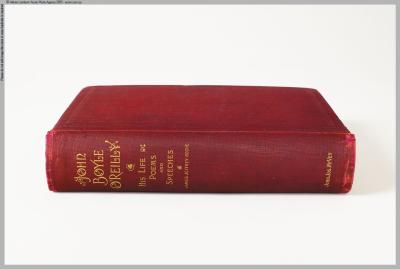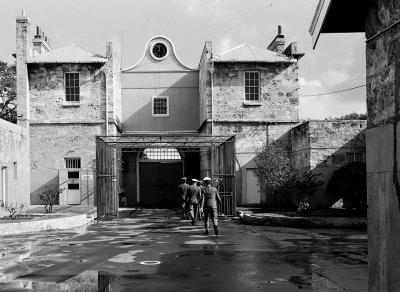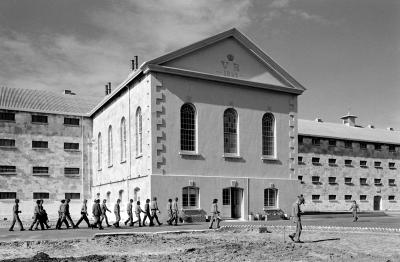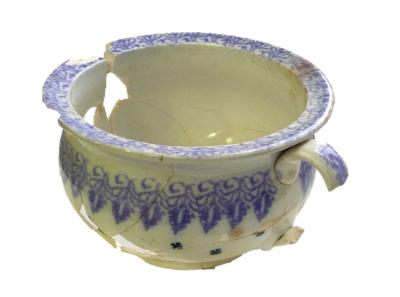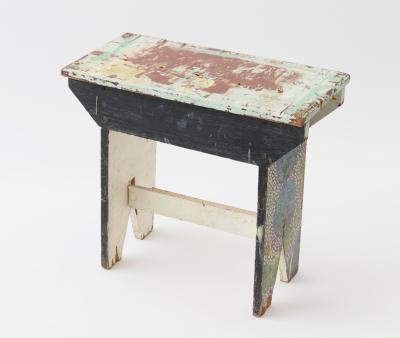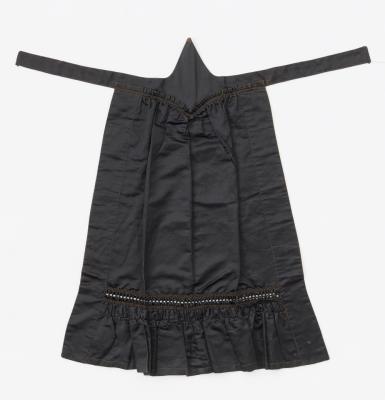WEIGHT FOR SCALES
c. 1810 - 1855Set of eight, metal weights, ranging from 1 ounce to 14lb. Each weight is stamped with the Broad Arrow symbol, as well as a shield with three horizontal swords, believed to be seaxes. All are made from thick metal with a metallic gold surface.
(a) Fourteen pound weight made from lead and plated in brass. Cylindrical bell shaped body tapering from 45mm diam near top to 60mm diam near base. The weight has a 110mm diam base. Bulbous partly spherical top (H32 x 75mm diam) capped by oval shaped (95 x 60mm) hand grip of thick metal. All marks imprinted into body. Near the top is, '14 B [broad arrow pointing upwards] O', then a shield containing three horizontal seaxes. Above the shield is 'No. 20' and on top of hand grip is '14 Pounds'.
(b) Seven pound weight made from lead and plated in brass. Cylindrical bell shaped body tapering from 40mm diam near top to 50mm diam near base. Weight has a 90mm diam base. Bulbous partly spherical top (H24 x 60mm diam) capped by oval shaped (70 x 45mm) hand grip of 10 x15mm metal. All marks imprinted into body. Near top is, '7 B [broad arrow pointing upwards] O' then a shield containing three horizontal seaxes. Above shield is 'No. 20' and on top of hand grip is '7 Pounds'.
(c) Four pound weight made from lead and plated in brass. Cylindrical bell shaped body tapering from 35mm diam near top to 40mm diam near base. Weight has a 73mm diam base. Bulbous partly spherical top (H24 x 50mm diam) capped by 60 x 40mm oval shaped hand grip of 7 x 15mm metal. All marks imprinted into body. Near top is, '4 B [broad arrow pointing upwards] O' then a shield containing three horizontal seaxes. Above shield is 'No. 20' and on top of hand grip is '4 Pounds'.
(d) Two pound weight made from lead and plated in brass. Cylindrical bell shaped body tapering from 30mm diam near top to 35mm diam near base. Weight has a 58mm diam base. Bulbous partly spherical top capped by 45 x 35mm oval shaped hand grip of 5 x 10mm metal. All marks imprinted into body. Near top is, '2 B [broad arrow pointing upwards] O' then a shield containing three horizontal seaxes. Above shield is 'No. 20' and on top of hand grip is '2 Pounds'.
(e) One pound weight made from lead and plated in brass. Cylindrical bell shaped body tapering from 25mm diam near top to 30mm diam near base. Weight has a 45mm diam base. Bulbous partly spherical top capped by 35 x 25mm oval shaped finger grip of 5 x 10mm metal. All marks imprinted into body. Near top is, '1 B [broad arrow pointing upwards] O' then a shield containing three horizontal seaxes. Above shield is 'No. 20' and on top of hand grip is '1 Pound'.
(f) Half pound weight made from lead and plated in brass. Cylindrical bell shaped body tapering from 20mm diam near top to 25mm diam near base. Weight has a 38mm diam base. Bulbous partly spherical top capped by 24 x 18mm oval shaped finger grip of 3 x 5mm metal. All marks imprinted into body. Near top is, 'B [broad arrow pointing upwards] O' then a shield containing three horizontal seaxes. Above shield is 'No. 20'.
(g) Four ounce weight made from lead and plated in brass. Cylindrical bell shaped body tapering from 15mm diam near top to 20mm diam near base. Weight has a 30mm diam base. Bulbous partly spherical top capped by 15 x 10mm oval shaped finger grip of 2 x 3mm metal. All marks imprinted into body. Near the top is a broad arrow pointing upwards, then a shield containing three horizontal seaxes. Imprinted on the base is '11'.
(h) One ounce weight made from lead and plated in brass. Cylindrical bell shaped body tapering from 10mm diam near top to 7mm diam at mid waist then flaring out to 10mm diam near base. Weight has a 24mm diam base. Bulbous partly spherical top capped by 12 x 10mm oval shaped finger grip of 4 x 4mm metal. One side of the finger grip has broken off and is missing. All marks imprinted into body. Near the tops is a broad arrow pointing upwards, then a shield containing three horizontal seaxes. Imprinted on the base is '11'.
Used in the kitchen at Barton's Mill Prison.
Details
Details
Whilst the specific purpose of these weights has been lost, each weight is stamped with the broad arrow symbol and ‘B O’, which stands for ‘British Ordinance’, which allows for their accurate dating. The British Ordinance was a government department in use during the early nineteenth century, through until 1855, which means these weights dated to the earliest period of convictism in Western Australia. These symbols were affixed to British government property of the time, including convict equipment and clothing, as a sign of ownership and a remedy against theft.
Enquiries made to an Associate Professor of the University of Tasmania in 2010, into the possible purpose of these weights, confirmed their date of manufacture as mid-nineteenth century. It was also hypothesized that their purpose could have been for food rations or postal services. It was commented that whilst most other weights from this period which bear the same markings are made of cast iron, few examples survive which are this decorative or in as good condition.
Mal Campbell, a private researcher (camwens@bigpond.net.au), contacted Fremantle Prison in 2021 while researching different weight measurements across Australia. He found these weights on the Fremantle Prison website. He identified the crest on these weights as being that of Middlesex County in the UK, and the three swords in the crest as being seaxes. According to Mal’s research, this version of the crest was in use until 1879. The ‘20’ (or possibly ‘2C’ or ‘2G’) stamped above the crest on some of these weights is the local inspector’s distinguishing number within the greater Middlesex County area. Please see document attached to this record for further information.
Weights and scales were used in the Convict Establishment to help the cooks ration out a man’s portion for each dish. The object they wished to measure, such as meat, would be placed on one side of a scale and weights on the other, until they were equal. As each convict’s diet was strictly allotted, scales were used at every meal to clearly ration out each man’s portion.
The health and wellbeing of the convicts inside the Establishment was the responsibility of the Surgeon. To assist with keeping the inmates fit and well, and to avoid any outbreaks of disease, the Surgeon was also responsible for designing a specially formulated diet. Dr. Rennie, the Convict Establishment’s Surgeon, was an advocate for a vegetarian and temperance diet. Whilst he strongly advocated for an overall reduction in the amount of food in the convict’s diet, he argued for an increase in the variety of vegetables and fish served to the men. Despite his recommendations, the final say on the convict diet lay with the Establishment’s Superintendent, who in this case ignored Dr. Rennie’s recommendations, and added more bread and potatoes to the convict’s rations.
During the time of the Convict Establishment the average inmate’s daily rations were set in the Convict Establishment Rules and Regulations and included the following; for breakfast a cup of tea and bread; for lunch some meat, potatoes, or sometimes vegetables and rice, plus a bowl of gruel or oatmeal soup; and for supper a cup of tea and bread. Whilst this might sound insufficient, convicts often ate better than most colonists of the time.
These convict era weights are of international significance. With strong provenance to the Fremantle Prison site, they are accurately dateable to the convict period from which the site gains its World Heritage listing. These artefacts are also intact and in remarkably good condition, compared to other weights of this type and period. They have research potential and high social significance as interpretive examples of the effects of rationing and the understanding of the correlation between certain foods and health during this time.

